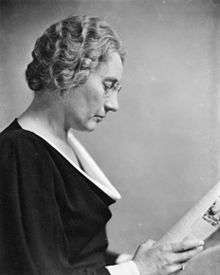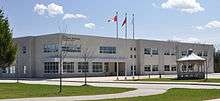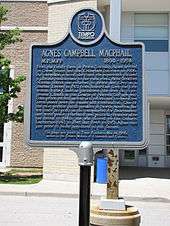Agnes Macphail
| Agnes Macphail | |
|---|---|
 Portrait by Yousuf Karsh, 1934 | |
| Member of Ontario Provincial Parliament | |
|
In office 1948–1951 | |
| Preceded by | John A. Leslie |
| Succeeded by | Hollis Edward Beckett |
|
In office 1943–1945 | |
| Preceded by | George Stewart Henry |
| Succeeded by | John A. Leslie |
| Constituency | York East |
| Member of the Canadian Parliament for Grey—Bruce | |
|
In office 1935–1940 | |
| Preceded by | New riding |
| Succeeded by | Walter Harris |
| Member of the Canadian Parliament for Grey Southeast | |
|
In office 1921–1935 | |
| Preceded by | Robert James Ball |
| Succeeded by | Riding abolished |
| Personal details | |
| Born |
Agnes Campbell Macphail March 24, 1890 Proton Township, Grey County, Ontario, Canada |
| Died |
February 13, 1954 (aged 63) Toronto, Ontario, Canada |
| Political party |
Co-operative Commonwealth Federation UFO-Labour Progressive |
| Residence | Toronto |
| Occupation | Schoolteacher |
Agnes Campbell Macphail (March 24, 1890 – February 13, 1954) was a Canadian politician who was elected to the House of Commons of Canada from 1921 to 1940. She was the first woman to be elected to parliament. From 1943 to 1945 and again from 1948 to 1951 she was a member of the Legislative Assembly of Ontario representing the Toronto riding of York East. Active throughout her life in progressive Canadian politics, Macphail worked for two separate parties and promoted her ideas through column-writing, activist organizing, and legislation.
Background
Agnes Macphail was born to Dougald McPhail and Henrietta Campbell in Proton Township, Grey County, Ontario on March 24, 1890. (Although her surname was spelled "McPhail" at birth, she discovered during a trip to Scotland that her family's surname had been "Macphail" and changed her name to reflect this.) She was raised in the Methodist Church, but converted to the Reorganized Latter Day Saint church as a teenager, the church of her missionary uncle.[1]
She attended Owen Sound Collegiate and Vocational Institute for one year. Even though she did well she transferred to Stratford Normal School so she could board with a relative. She graduated in 1910 with a second class teacher's certificate. She applied for five positions and was accepted at all five. She claimed that this was not due to her competence but due to a scarcity of teachers at the time.[2] She taught in several rural schools in such communities as Port Elgin, Honeywood and Newmarket.
While working in Sharon, Macphail became active politically, joining the United Farmers of Ontario (UFO) and its women's organization, the United Farm Women of Ontario. She also became a columnist for the Farmer's Sun around this time.
Federal politics
After amendments to the Elections Act by the Conservative Party government in 1919, Macphail was elected to the House of Commons as a member of the Progressive Party of Canada for the Grey Southeast electoral district (riding) in the 1921 federal election. She was the first woman Member of Parliament (MP) in Canada. Macphail was re-elected in the 1925, 1926, and 1930 federal elections.
Macphail objected to the Royal Military College of Canada in 1924 on the grounds that it taught snobbishness and provided a cheap education for the sons of the rich and again in 1931 on pacifist grounds.[3]
As a radical member of the Progressive Party, Macphail joined the socialist Ginger Group, faction of the Progressive Party that later led to the formation of the Co-operative Commonwealth Federation (CCF). She became the first president of the Ontario CCF in 1932.[4] However, she left the CCF in 1934 when the United Farmers of Ontario pulled out, over fears of Communist influence in the Ontario CCF.[5] While Macphail was no longer formally a CCF member, she remained close to the CCF MPs and often participated in caucus meetings. The CCF did not run candidates against Macphail in her three subsequent federal campaigns.
In the 1935 federal election, Macphail was again elected, this time as a United Farmers of Ontario–Labour MP for the newly formed Grey—Bruce riding.[6] She was allowed to use the party's name, even after it stopped being a political organization in 1934. She was always a strong voice for rural issues. Macphail was also a strong advocate for penal reform and her efforts contributed to the launch of the investigative Archambault Commission in 1936. The final report became the basis for reform in Canadian penitentiaries following World War II.[7] Macphail's concern for women in the criminal justice system led her, in 1939, to found the Elizabeth Fry Society of Canada, named after British reformer Elizabeth Fry.
Causes she championed included pensions for seniors and workers' rights. Macphail was also the first Canadian woman delegate to the League of Nations in Geneva, Switzerland, where she worked with the World Disarmament Committee. Although a pacifist, she voted for Canada to enter World War II.
In the 1940 election, she was defeated. With the death of United Reform MP for Saskatoon City, Walter George Brown, a few days after the election, Macphail was recruited by the United Reform Movement to run in the by-election to fill the seat. On August 19, she was defeated by Progressive Conservative candidate Alfred Henry Bence. He received 4,798 votes, while Macphail placed second with 4,057 votes.[8] It was her last federal campaign as a candidate.
Journalist
Macphail was a frequent contributor to newspapers in Grey County such as the Flesherton Advance, often acting as a correspondent or ambassador to the rest of the country.[9] She wrote dispatches from Parliament about political news of interest to the rural communities back home, and contributed columns when she travelled and spoke to citizens in other regions.[10] She also wrote a number of pieces for The Farmer's Sun, an Ontario progressive weekly, including a number of reminiscences about rural Ontario history.[11]
Out of office, she wrote agricultural columns for The Globe and Mail newspaper in Toronto and contributed pieces about politics to the Newmarket Era.[12]
Following a family tragedy in her home town, Macphail moved to the Toronto suburb of East York, Ontario and rejoined the Ontario CCF in 1942 becoming its farm organizer.
Provincial politics
In the 1943 provincial election, Macphail was elected to the Legislative Assembly of Ontario as a member of the Ontario CCF representing the suburban Toronto riding of York East.[13] She and Rae Luckock were the first women elected to the Ontario Legislature. She was the first woman sworn in as an Ontario Member of Provincial Parliament (MPP). Although defeated in the 1945 provincial election, she was elected again in the 1948 election. Macphail was responsible for Ontario's first equal-pay legislation, passed in 1951, but was unable to continue her efforts when she was defeated in elections later that year. At that time, Macphail was barely able to support herself through journalism, public speaking and organizing for the Ontario CCF.
Macphail was eager to see more women in politics. She explained: "Most women think politics aren't lady-like. Well, I'm no lady. I'm a human being."[7]
Macphail never married. She died February 13, 1954, aged 63, in Toronto, just before she was to have been offered an appointment to the Senate of Canada. She is buried in Priceville, Ontario, with her parents and Gertha Macphail, one of her two sisters.
Electoral record
| Ontario general election, 1943 | ||||||||
|---|---|---|---|---|---|---|---|---|
| Party | Candidate | Votes | % | ±% | ||||
| Co-operative Commonwealth | Agnes Macphail | 12,016 | 46.4 | |||||
| Progressive Conservative | John A. Leslie | 10,440 | 40.3 | |||||
| Liberal | H.J. McConnell | 3,459 | 13.3 | |||||
| Total valid votes | 25,915 | 100.0 | ||||||
| Montreal Gazette (Google News)[13] | ||||||||
Federal: Saskatoon City
| By-election on 19 August 1940 | |||||
| Party | Candidate | Votes | |||
|---|---|---|---|---|---|
| Conservative | Alfred Henry Bence | 4,798 | |||
| United Reform | Agnes MacPhail | 4,057 | |||
| Liberal | Michael Patrick Hayes | 2,421 | |||
| Independent Liberal | Sidney Walter Johns | 2,250 | |||
| Independent Social Credit | George Howard Bradbrooke | 1,200 | |||
| Independent | Agnes Wilna Moore | 491 | |||
Federal: Grey—Bruce
| Canadian federal election, 1940: Grey—Bruce | ||||||||
|---|---|---|---|---|---|---|---|---|
| Party | Candidate | Votes | ||||||
| Liberal | HARRIS, Walter Edward | 6,389 | ||||||
| National Government | KNECHTEL, Karl Daniel | 4,944 | ||||||
| United Farmers of Ontario–Labour | MACPHAIL, Agnes Campbell | 4,761 | ||||||
| Canadian federal election, 1935: Grey—Bruce | ||||||||
|---|---|---|---|---|---|---|---|---|
| Party | Candidate | Votes | ||||||
| United Farmers of Ontario–Labour | MACPHAIL, Agnes C. | 7,210 | ||||||
| Liberal | HALL, Walter Allan | 5,727 | ||||||
| Conservative | CAMPBELL, Lewis G. | 5,100 | ||||||
Federal: Grey Southeast
| Canadian federal election, 1930 | ||||||||
|---|---|---|---|---|---|---|---|---|
| Party | Candidate | Votes | ||||||
| Progressive | Agnes Campbell MacPhail | 6,619 | ||||||
| Liberal | Lewis G. Campbell | 6,376 | ||||||
| Canadian federal election, 1926 | ||||||||
|---|---|---|---|---|---|---|---|---|
| Party | Candidate | Votes | ||||||
| Progressive | Agnes Campbell MacPhail | 7,939 | ||||||
| Conservative | Robert Thomas Edwards | 6,211 | ||||||
| Canadian federal election, 1925 | ||||||||
|---|---|---|---|---|---|---|---|---|
| Party | Candidate | Votes | ||||||
| Progressive | Agnes C. MacPhail | 6,652 | ||||||
| Conservative | Lewis G. Campbell | 5,245 | ||||||
| Canadian federal election, 1921 | ||||||||
|---|---|---|---|---|---|---|---|---|
| Party | Candidate | Votes | ||||||
| Progressive | Agnes Campbell MacPhail | 6,958 | ||||||
| Conservative | Robert James Ball | 4,360 | ||||||
| Liberal | Walter Hastie | 2,638 | ||||||
Legacy


- In 1968, when Flesherton High School was replaced by Grey Highlands Secondary School, the old high school was converted to an elementary school and named Macphail Memorial Elementary School. This building was replaced with a new school of the same name in 2006.
- In 1981, a public school in Scarborough, Ontario was named after her.[14]
- In 1993, honouring the 50th anniversary of Macphail's election to the Ontario legislature, Michael Prue, the mayor of East York, declared March 24 would annually be known as Agnes Macphail Day.
- In 1994, East York council established the Agnes Macphail Award. The award is given out annually to "a resident of East York who has made outstanding contributions in the area of equality rights and social justice and who has exemplified and continued Macphail's tradition of leadership."[15]
- In 1997, East York inaugurated the annual Agnes Macphail public speaking contest for students. In addition, there are a number of sites and endeavours named for her in East York, including the Agnes Macphail Parkette, located at the corner of Mortimer Street and Pape Avenue; the Agnes Macphail Playground, Agnes MacPhail Youth Resource Centre and the Agnes MacPhail Food Bank (all located at 444 Lumsden Avenue).
- In 1999, a new townhome development was built by Brownstone Homes and named a street after her, Macphail Ave, also at Pape & Mortimer.[16]
- In 2005, in a contest run by former Ontario MPP Marilyn Churley, Agnes Macphail was voted as the Greatest Ontario Woman.
- On June 24, 2006, a cairn and bronze bust commemorating Agnes Macphail's life was unveiled in Hopeville, Ontario. The same year, highway signs labelled "You are now entering Agnes Macphail Country" were placed at the eastern approach to the hamlet of Ceylon, at the intersection of Grey Roads 4 and 14 (known locally as "Six Corners"), and on Grey Road 9, east of Hopeville. Grey County Road 9 between Highway 6 and highway 10 was named Agnes MacPhail Road.[17]
- An apartment building at 860 Mercer Street in Windsor, Ontario, is named "Agnes Macphail Manor".
- A 2015 episode of Murdoch Mysteries (season 8, episode 17, "Election Day") sees a young Agnes Macphail (played by Zoe Fraser) showing an interest in the suffragette movement.
- She appears on the 2017 "Canada 150" edition of the Canadian ten-dollar bill alongside John A. Macdonald, George-Étienne Cartier and James Gladstone and is the first woman other than the sovereign to have a permanent spot on Canadian currency.[18]
References and notes
Notes
- ↑ "Archived copy". Archived from the original on 2012-07-11. Retrieved 2009-07-03.
- ↑ Pennington, Doris (1989). Agnes Macphail: Reformer. Toronto: Simon & Pierre Publishing Company Ltd. p. 19. ISBN 0-88924-212-7.
- ↑ R. Preston 'Canada's RMC: A History of the Royal Military College' (Toronto, University of Toronto Press, 1969)
- ↑ Stewart & Shackelton (1959), pp. 171–172
- ↑ Stewart & Shackelton (1959), p. 178
- ↑ "Candidates". History of Federal Elections since 1867. Elections Canada. Retrieved 2007-05-06.
- 1 2 "First Woman MP, Miss Macphail Dies". Kitchener-Waterloo Record (Microfilm)
|format=requires|url=(help). Canadian Press. February 15, 1954. p. 5. - ↑ "By-Elections: SASKATOON CITY (1940/08/19)". History of Federal Elections since 1867. Elections Canada. Retrieved 2007-05-06.
- ↑ "Flesherton Advance, 22 Jul 1931, p. 4". images.ourontario.ca. Retrieved 2018-03-16.
- ↑ "Flesherton Advance, 23 Dec 1931, p. 8". images.ourontario.ca. Retrieved 2018-03-16.
- ↑ "Women Pioneers of Proton Part 1". images.ourontario.ca. Retrieved 2018-03-16.
- ↑ "Newmarket Era (Newmarket, ON1861 ), 29 May 1931, p. 8". news.ourontario.ca. Retrieved 2018-03-16.
- 1 2 Canadian Press (1943-08-05). "Ontario Election Results". The Gazette. Montreal. p. 12.
- ↑ "Agnes Macphail PS". Schools. Toronto District School Board. 2007. Archived from the original on 12 October 2007. Retrieved 2007-09-20.
- ↑ The Agnes Macphail Award. City of Toronto. Accessed April 2, 2009
- ↑ EastYorkRealtor.com
- ↑ "The Agnes Macphail Digital Collection: Agnes Macphail Country Sign". Grey Highlands Public Library. 2007. Retrieved 2010-02-09.
- ↑ http://www.bankofcanada.ca/banknotes/banknote150/
References
- Stewart, Margaret; Shackelton, Doris French (1959). Ask no quarter; a biography of Agnes Macphail. Toronto: Longmans,Green.
- Young, Walter D. (1969). The Anatomy of a Party: The National CCF, 1932–61. Toronto: University of Toronto Press. ISBN 0-8020-5221-5.
External links
| Wikimedia Commons has media related to Agnes Macphail. |
- Works by or about Agnes Macphail at Internet Archive
- The Canadian Encyclopedia, Agnes Macphail
- Agnes Macphail Website and Digital Collection
- Celebrating Women's Achievements - Agnes Campbell Macphail
- Agnes Macphail – Parliament of Canada biography
- Ontario Legislative Assembly parliamentary history
- CBC Digital Archives - CCF's Agnes Macphail and the 1948 Ontario election, radio address by Macphail.